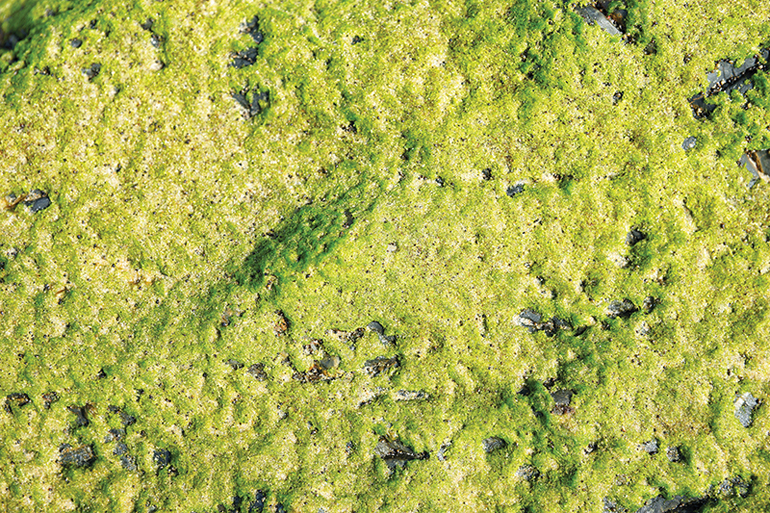
Copper is an incredibly diverse element. Depending on the selected chemical formulation, it can be used in a variety of ways. Copper in its different forms is found in artwork, plumbing, wiring and many other areas. In 2016, more than 19 million tons of copper were mined around the world, with 1.4 million tons coming from the United States. Needless to say, copper is everywhere, and all estimates suggest that its production will only increase as the nations of the world continue to develop their infrastructure and economies.
[box style=”rounded” border=”full”]>> Need More Water Quality Content? Visit all articles related to the topic[/box]
However, just as copper is everywhere, so is water. Too often, the results of copper mining and usage end up leaving residual copper in the water. But fear not — not all copper is the same, and not all copper is necessarily bad.
One of the major environmentally beneficial uses of copper nowadays is to control algae. Algae can be found in practically every pond, serving important roles in the water, such as aiding in oxygen production and acting as a food source. Unfortunately, anyone who has spent enough time around ponds has seen what happens when algae get out of control. Affected ponds can go from picturesque to green soup over the course of a day. In cases like this, immediate action is needed. While algae can serve as a positive factor most of the time, they represent a real threat to all other life in the water when they bloom. Not only do blooms of algae take up large amounts of oxygen, but some species even produce toxins that are deadly to other organisms. So, if this becomes a problem for a pond owner, what is the most effective approach?
Copper-based Algaecides
Copper crystals (granular) are exactly what they sound like — crystallized copper. This is the cheapest and oldest method of applying copper as an algaecide. Just throw it into the water where algae is present, and the crystals will dissolve, killing the algae it comes in contact with. While this sounds easy enough, this method is also the most damaging. Copper crystals only kill what they touch, so a large pond could require quite a bit of copper to achieve an effective result.
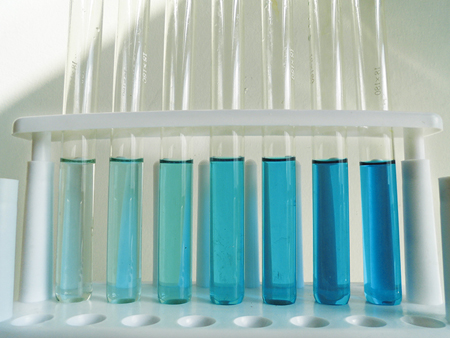
A second approach, liquid copper, covers a very wide range of products that use different mixes of copper to varying effects. Liquid copper is more efficient than copper crystals because it can actually stay suspended in water for a longer period of time — copper crystals tend to sink straight to the bottom. However, the same issue remains: To achieve the most algae kills, more product needs to be used.
A third category to consider is chelated copper, a slightly more complex version of liquid copper. Chelated copper algaecides are also liquid, but they are defined by that first word — chelated. This is the name given to a chemical process where a form of protective covering attaches to the copper atoms. Chelation is analogous to the shell around M&M candy. The shell around the chocolate protects it from the outside, and it only starts to break apart in response to heat (or in this case, being chewed). The goal of using chelators is so that the main ingredient of the product isn’t used up too quickly. So when chelated copper is applied to a bloom, the copper releases more gradually, as the protective covering slowly dissolves in the water. This creates a longer period of actively killing algae while requiring less copper usage, since the product works for an extended period. Thus, this is the most ecologically friendly choice.
While these are the three general categories of copper-based algaecide, there really are not that many varieties for sale on the market. Even though there is not an array of choices, it can still be tough to figure out what the right choice is. Chelating agents tend to be proprietary, and finding out what products are natural or organic can be next to impossible. It can also be a task trying to find copper products that are easy on the ecosystem — but if you can find the right product, it can be a great solution.
[box style=”rounded” border=”full”]>> Related Article | Polyquat Algaecide: How Does it Affect the Ecosystem?[/box]
Don’t box me in the environment and can be found at varying levels within sediment that has never been touched by human copper products, we have to be aware of the fact that in excessive amounts, copper can become a problem. So, it makes sense that when considering copper algaecides, you want to make sure to use a solution that contains the smallest amount of copper while still producing the greatest results.
Why is Copper Balance Important?
Regardless of the source, copper ends up binding to organic matter, and when it reaches the sediment layer, it resides in the upper few inches of substrate where this organic matter is concentrated. This section of the sediment hosts some of the most vital organisms in a freshwater ecosystem — beneficial bacteria, plants and invertebrates, just to name a few. They call this area home, and together they make up the base of the freshwater food web. Smaller organisms feed on floating detritus (plant material) and microorganisms, and the levels of consumption keep rising.
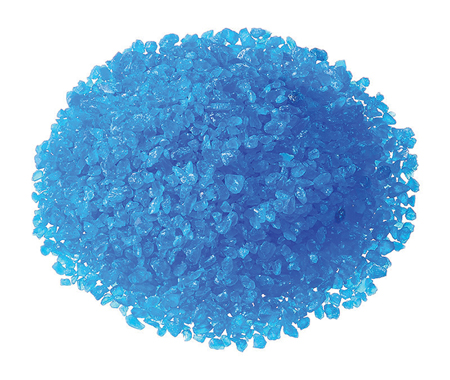
An example of these levels in fresh water would be how a phytoplankton photosynthesizes. It is eaten by a larval fish; this larval fish is eaten by a sunfish; and the sunfish is then grabbed from the water by a heron. This is an extremely generalized view of the flow of life, but it depicts an integral part of ecology. It’s important to note that it all starts at the bottom. Without plants and microorganisms, the smaller organisms have no food; in turn, the bigger organisms have nothing to eat. It seems clear that maintaining healthy sediment is the key to a functioning ecosystem and a sustainable pond.
If an algae bloom is starting to spread, the health of the pond must be an immediate concern. It may be obvious that the bloom needs to be dealt with, but the massive number of products available for this exact situation can be quite daunting. This is where chelated copper can be a great asset. Not only can the bloom be killed with a small dose, but it can be done with a minimal amount of copper added to the ecosystem. This small amount of copper also enables the use of different products after application. One of the most common supplements to a chelated copper application is an enzyme product, with additional bacteria added a few days after applying the chelated copper. These speed up the decomposition of dead algae as they sink, reducing the chance of a reoccurring bloom. The fact that chelated copper works well with these organisms is proof of how much less damaging it can be, compared to products that use copper crystals.
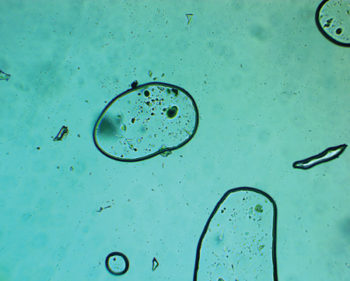
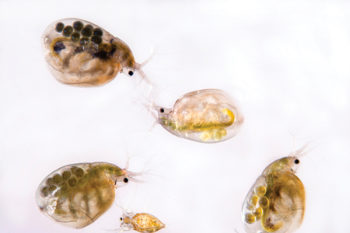
[box]Left picture, freshwater algae species are shown at 400x magnification while, right, a common water flea under the microscope (Daphnia pulex)[/box]
Overall Pond Balance
Keeping balance in a pond is something that every pond owner strives for. It is easy to forget that the ponds we see may look peaceful, but there is always an ongoing battle for resources and space among many different organisms. Algae are no exception to this, and they are one of the most successful organisms at rapidly expanding when the conditions are right. Control needs to happen quickly and decisively, but when algae clear up, every pond owner still wants their plants and fish to thrive. Chelated copper is a great way to tackle this issue and leave the rest of the environment capable of flourishing after the algae subside. The best treatment method is the kind that specifically targets the problem, with as few side effects as possible. If utilized correctly, this solution can be built around chelated copper.


